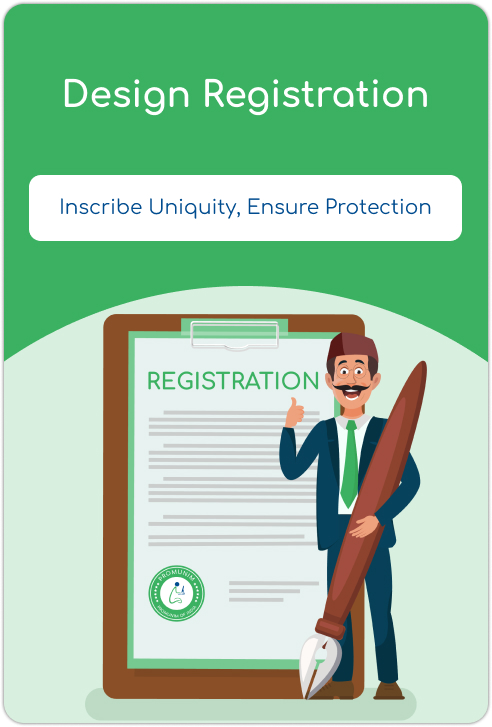
Design Registration
744 customers
What will you get?
Filing Design registration
Registration certification
What do we Require?
INR 11955 Taxes As Applicable











Introduction
Design registration is a legal process that safeguards the visual appearance of a product by registering its unique and non-functional aspects with the relevant intellectual property office. It provides the registered owner with exclusive rights to use, license, and enforce the design, preventing unauthorized copying or imitation. To qualify, a design must meet specific criteria, such as novelty and distinctiveness, and not have been disclosed to the public before the application. Once registered, the owner gains legal protection, allowing them to take action against infringers and seek remedies like injunctions, damages, and seizure of infringing products. The registration and protection of industrial designs in India is administered by the Designs Act , 2000 and corresponding Designs Rules , 2001 which came into force on 11th May 2001 repealing the earlier Act of 1911. The Design Rules, 2001 was further amended by Designs (Amendment) Rules 2008 and Designs (Amendment) Rules 2014. The last amendment in Designs Rules came in to force from 30th December, 2014, which incorporates a new category of applicant as small entity in addition to natural person and other than small entity.
Basic Requirements of Design Registration:
- Novelty:The design must be new and original, meaning it has not been disclosed to the public anywhere in the world before the date of application. It should not be identical or similar to any existing designs.
- Distinctiveness:The design should possess individual character, meaning it should significantly differ from existing designs. It must have a unique appearance that sets it apart from other designs in the marketplace.
- Industrial Applicability:The design should be capable of being applied to an article of manufacture, whether it's a product's shape, configuration, pattern, or ornamentation. It must be suitable for mass production and commercial use.
- Non-functional Elements:The design should primarily focus on aesthetic or ornamental aspects rather than functional features. Functional elements are typically protected by patents rather than design registrations.
- Proper Representation:The design application should include accurate representations or drawings of the design from different perspectives, providing clear and complete views of the ornamental features.
- Application Filing:A formal application for design registration needs to be filed with the appropriate intellectual property office or authority in the jurisdiction where protection is sought. This application should include details about the applicant, the design, and any priority claims if applicable.
- Examination and Registration:The design application will undergo an examination process to ensure it meets the legal requirements for registration. If the design satisfies the criteria and there are no objections or oppositions, it will be registered, granting the owner exclusive rights to use the design and prevent others from unauthorized copying or imitation.
Duration of Protection:
Design registrations typically provide protection for a limited period, which varies depending on the jurisdiction but is commonly around 10 to 15 years, subject to renewal fees. Renewal: To maintain protection, the owner of the registered design must pay renewal fees periodically as required by the relevant intellectual property office.
Territorial scope works in design registration:
- National Registration:In many countries, design registration is governed by national laws. This means that an applicant must file a separate application with the national intellectual property office of each country where they seek protection for their design. Once registered, the design is protected only within the borders of that country.
- Regional Registration:Some regions have established systems for regional design registration. For example, the European Union offers a system for registering designs that provides protection across all member states of the EU through a single registration process. Similarly, the African Regional Intellectual Property Organization (ARIPO) allows for registration of designs that provide protection in multiple member countries in Africa.
- International Registration:The Hague System for the International Registration of Industrial Designs provides a mechanism for obtaining design protection in multiple countries through a single international application. This system allows applicants to designate member countries where they seek protection for their design. However, it's important to note that the Hague System is not available in all countries, and it requires applicants to meet certain eligibility criteria.
- Priority Claim:In some cases, an applicant may benefit from a priority claim based on an earlier application filed in their home country. This allows them to file subsequent applications in other countries within a specified time frame while maintaining the priority date of the original application. Priority claims can help streamline the process of seeking protection in multiple jurisdictions.
- Exhaustion of Rights:Once a design is registered in a particular jurisdiction, the rights conferred by that registration are typically exhausted within the borders of that jurisdiction. In other words, the owner of a registered design cannot prevent the importation or sale of products incorporating the design in other jurisdictions where the design is not registered.
Benefits:
- Exclusive Rights:Design registration grants the owner exclusive rights to use the design, protecting the investment made in its creation.
- Legal Protection:Registered designs are legally protected, allowing for legal action against infringers.
- Market Differentiation:Design registration helps distinguish products from competitors, enhancing brand reputation and consumer loyalty.
- Commercialization Opportunities:Registered designs can be licensed or sold to third parties, providing revenue generation opportunities.
- Enhanced Market Access:Design registration facilitates market access by providing a legal basis for participating in trade fairs and preventing unauthorized copying.
- Investment Protection:Design registration safeguards investment in new designs by providing a legal framework against imitation.
- Long-Term Value:Registered designs provide on-going protection for 10 to 15 years, with renewal options available.
- Deterrent Effect:Design registration acts as a deterrent to potential infringers, reinforcing the design's value and deterring unauthorized use.
Documents Requirement:
- Application Form:Formal application form requiring applicant's details, design name, description, and other information.
- Drawings or Representations:Clear, accurate representations of the design from different perspectives.
- Statement of Novelty or Statement of Originality:A statement declaring the design is new and original.
- Priority Document:If claiming priority based on an earlier application, a priority document may be required.
- Power of Attorney:In some jurisdictions, a power of attorney may be required if the application is filed by a representative.
- Proof of Payment:Evidence of payment of filing or official fees.
- Declaration or Affidavit of Ownership:A signed declaration confirming ownership of the design.
- Translations:If application documents are not in the official language, certified translations may be required.
- Other Supporting Documents:Additional documents may be requested based on specific requirements.

